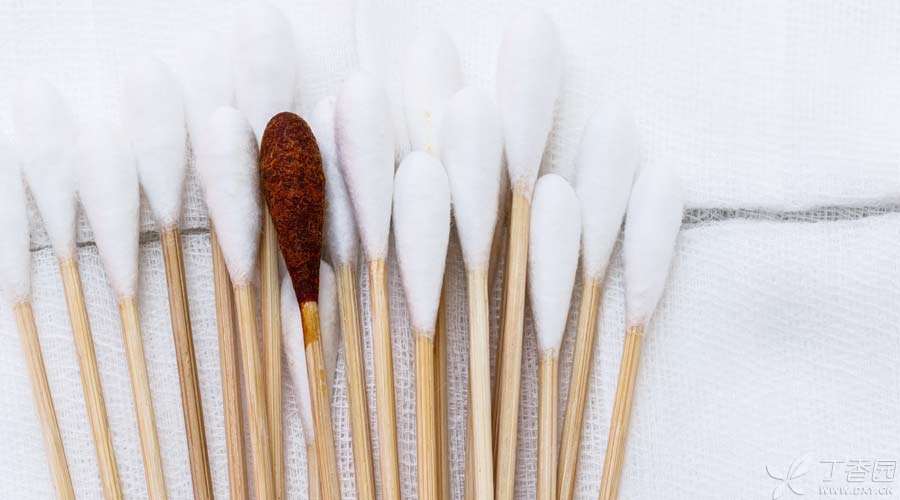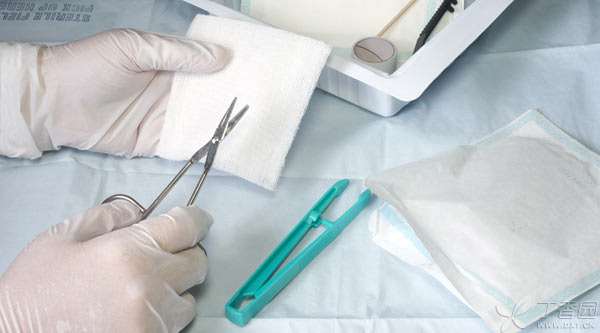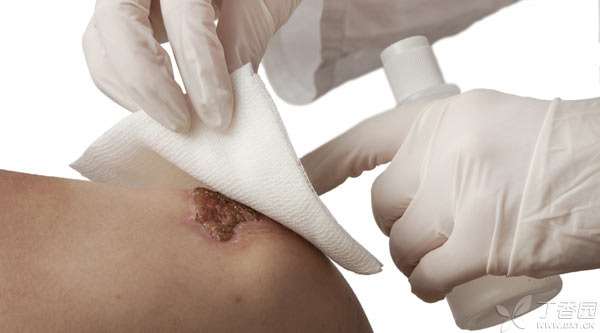
There are many contacts with patients in the hospital, and many strange things are really encountered.
For example, when I was practicing in the wound center of the hospital (a place where people change dressings), I met an old lady from a remote mountainous area. As soon as she entered the clinic, a stench came on her face. Looking back, the dried left lower limb grew a lump of [cauliflower]-a festering malignant tumor.
Further inquiries about the medical history, the original old lady two years ago accidentally scalded the left calf, but has not taken it seriously, intermittently using folk prescriptions to apply external application to herself. For more than two years, the wound has not healed, repeated suppuration and inflammation, and then canceration. Finally, even the bed can’t get off, this was carried to the hospital by the family.
In the process of helping the old lady clean, it took us some time just to remove the unknown powder and dregs of various colors around the wound.
If it is understandable that the old lady’s illness was delayed due to her low educational level, then another example of a white-collar girl is really [made].
The girl is as beautiful as a flower, A pair of chest apparatus is even more proud, but it is a pity that inflammation and suppuration of the breast bring difficulties. The girl loves beauty and is unwilling to listen to the doctor’s advice for surgery. She went to a private clinic to choose the so-called “conservative treatment”. The clinic applied a red powder of unknown nature to the wound externally and matched it with moxibustion, abruptly turning the girl’s twin peaks into a “crater”.
The problem that could have been solved by a small incision may now require several knives and leave ugly scars.

Many patients feel that it is a mountain out of a molehill to run to the hospital because of some small wounds. Even if you go to the hospital, it is nothing more than disinfecting a poison and changing a piece of gauze. If you buy materials from a pharmacy or a treasure, you can handle them yourself at home. Why do you need to go to the hospital so bother?
It is true that for healthy people, bruises and lacerations mostly heal within a few weeks without special treatment. However, as for what kind of wound to treat and what kind of treatment to carry out, it is far from as simple as it seems.
The above two examples are the best proof that if one is smart enough to delay one’s illness, the pain brought to the patient is likely to be irreparable.
In the case of what, small wounds also need to be seen in the hospital?
I remember there was an episode in the biography of Zhen Huan. An Lingrong gave Zhen Xuan a bottle of [Shucha Glue], saying that it could help Zhen Xuan heal the wound of the cat’s paw without leaving scars. The actual effect is really good (although musk is added). If there is such a magic medicine to accelerate wound healing in real life, no matter how expensive it is, someone will rush to buy it.
However, magic drugs only exist in artistic works after all. In reality, wound healing has its own rules. For general surgical incisions, healing requires a series of processes such as hemostasis, inflammatory reaction, tissue hyperplasia, scar formation, etc., which takes 2-4 weeks.
If there is too much necrotic tissue in the wound, complicated with infection, local blood flow is not smooth, and the healing process is easy to be interrupted or prolonged, the wound will become chronic.
Once the wound becomes chronic, it is difficult to heal itself without going to the hospital for special care.
With the increase of patients with chronic diseases and the elderly population, more and more people are troubled by chronic wounds. Common situations include:
- Ulcer Caused by Varicose Veins of Lower Limbs Diabetics, Foot Ulcer, Cancer Patients, Paralysis Patients, Long-term Bed Stay Causes Pressure Ulcers and
Other risk factors leading to wound persistence include: peripheral arterial lesions, old age, long-term malnutrition, long-term administration of immunosuppressive drugs such as hormones, HIV infection, smoking, etc.
Chronic wound may be the result of the combined action of various injury factors. Medical staff often need to combine etiological treatment when treating wounds, so as to promote wound healing to the greatest extent.
For example, if the long-term blood sugar control of diabetic patients is not good, hyperglycemia will cause peripheral neuropathy, causing limb numbness or insensitivity. Patients cannot sense and remove the injury factors in time, and tissue damage is often more serious during trauma.
Moreover, diabetes causes vascular inflammation, which leads to vascular obstruction, poor blood supply to wound tissue and hindered healing process.
In addition, diabetics suffer from systemic immune function decline, wound persistence is not healed, and infection is easy to occur.
Therefore, even if only shoes rub and blister, diabetics may suffer from secondary foot ulcer. Failure to intervene in time will worsen and lead to wound inflammation and gangrene, even requiring amputation. Simple dressing change does not control blood sugar, which is only a temporary solution but not a permanent cure.
Yourself [dressing change]? Nothing [good] but fun
The purpose of dressing change for wounds is to promote wound healing. However, this requires that neither problems should be left untreated so as to delay the illness, nor should random treatment be taken for granted so as to gild the lily.
Like the two examples cited at the beginning of the article, many patients are either too troublesome or too slow to heal the wound for fear of leaving scars. They listen to the secret recipe of folk remedies and purchase Chinese herbal medicines or powder with unknown ingredients to apply the wound externally, but they often backfire.
These drugs purchased through informal channels are often not fully sterilized and can easily lead to infection when applied to wounds.
Many folk therapies still retain the misconception that dry wounds are better than wet wounds. Most of the selected drugs are corrosive to cauterization. Moxibustion, scorching and other treatment measures will not only hurt deep tissues such as dermis and blood vessels, but also seal the wound so that the wound surface will not receive sufficient oxygen supply, and the internal pus and exudate cannot be smoothly removed. Repeated stimulation of the wound will lead to prolongation.
Many families will bring their own medicine boxes, of which disinfectants such as mercurochrome, mercurochrome, iodine and alcohol are necessary.
However, a disinfectant is not suitable for all daily wound disinfection. For example, iodine, alcohol, although the disinfection effect is good, but irritant, large area or deep trauma should not be used, oral mucosa tissue such as not directly applied.
Mercurochrome disinfection effect is weak, and contains mercury, large-scale use can cause mercury poisoning. Although mercurochrome has little irritation and good disinfection effect, it is easy to form scab membrane on the wound surface after use, and pus and exudate of necrotic tissue are not drained smoothly. It is easy to spread to the deep part, which can aggravate infection, and it may also leave purple marks on the skin surface and affect the appearance.

Do you want to change [medicine]? You have to listen to the doctor.
Many patients often complain: [Every dressing change is to wash wounds and change dressings, and I am dismissed without even seeing the shadow of “medicine”! ]
This is in fact a misunderstanding of medical personnel.
Wound healing has its own rules. Whether to use drugs and how to use them all need specific analysis of specific problems.
As a measure of wound care, medication is also aimed at building a good wound growth environment. Blind medication not only cannot accelerate healing, but also may delay this process.
For example, although wound infection is a problem, routine use of antibiotics has no obvious effect on preventing wound infection, and there is no evidence that antibiotic treatment can accelerate wound healing. Antibiotics are also irritating to wounds and may further delay wound healing.
Of course, if the wound already has local infection manifestations such as suppuration, cellulitis and malodor, or systemic infection manifestations such as fever and chills, it is necessary to timely use antibiotics in the whole body or part for intervention.
If it is really necessary to use antibiotics on the wound, It is necessary to choose [external dosage form]. If the injection or powder is applied topically, or the tablets taken are ground into powder and applied to the wound, the drug will be diluted or rapidly absorbed by the wound exudate, which cannot form a long-term effective antibacterial concentration locally. It is not only useless to prevent infection, but also may increase the generation of drug-resistant strains and medical expenses.
For some chronic wounds, such as chronic ulcers occurring in lower limbs, medical staff will also suggest external use of human growth factor preparations to help wound growth. In addition, silver ion dressings that can kill bacteria and receptor blockers that promote keratinocyte migration may also help wound healing.
Changing dressings is not just gauze and cotton mats.
As early as the end of the 18th century, bacteriologist Pasteur discovered that gauze covering wounds can keep dry, thus avoiding bacterial infection and helping wound healing. [Drying Therapy] thus dominated wound care for more than 150 years.
Until the middle of last century, British scholar George D.Winter found that moist wounds healed faster after conducting animal experiments. In 1972, David Rovee confirmed through human experiments that the healing speed of closed moist wounds was 1.5 times that of dry wounds exposed to air. Since then, moisturizing dressings have gradually received attention and related research has made rapid progress.
With the development of medical technology, wound dressings have long been more than only gauze and cotton pads. At present, there are more than 2,500 dressing products to choose from, and the number is still increasing.
Various dressings can not only fully fill the dead cavity of wounds, inhibit bacterial growth, relieve local pain and resist local inflammation, but also enhance the strength and function of repairing skin tissues and even avoid the formation of ugly scars.
However, the most important function of dressing is to maintain a certain moist environment required for wound healing.
The new artificial dressing can avoid the secondary damage to the wound caused by dressing change. The dressing made of special materials such as seaweed gum, silver ions, collagen, etc. can not only absorb exudate, breathe and moisturize, but also inhibit the growth and reproduction of bacteria, resist sticking and promote healing.
However, no one dressing is suitable for all patients, and it is undoubtedly a technical task to choose a dressing suitable for the patient’s condition. Moreover, the choice of dressing is not once and for all. As the repair process progresses, the wound characteristics are constantly changing, and the requirements for dressing will also vary.
In addition, although the new dressing is beneficial to chronic wound healing, its high price is also a big burden for patients who need long-term use. These problems need to be considered by patients and wound care experts.
Editor: Ding Ruoshui
Author: Cheyenne
